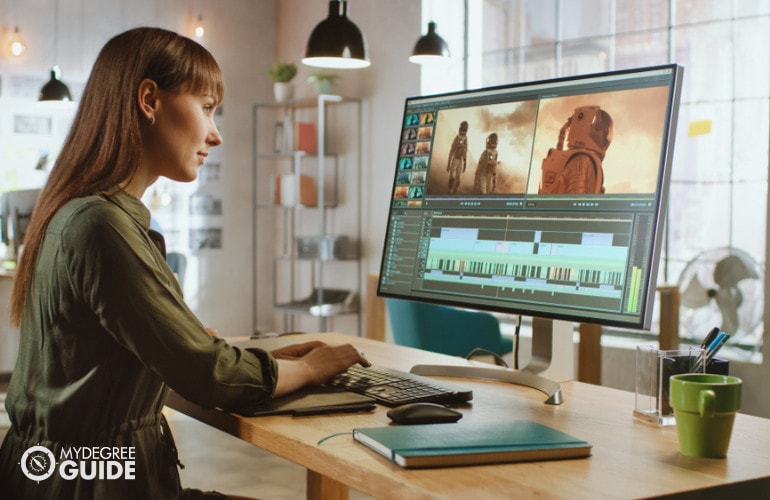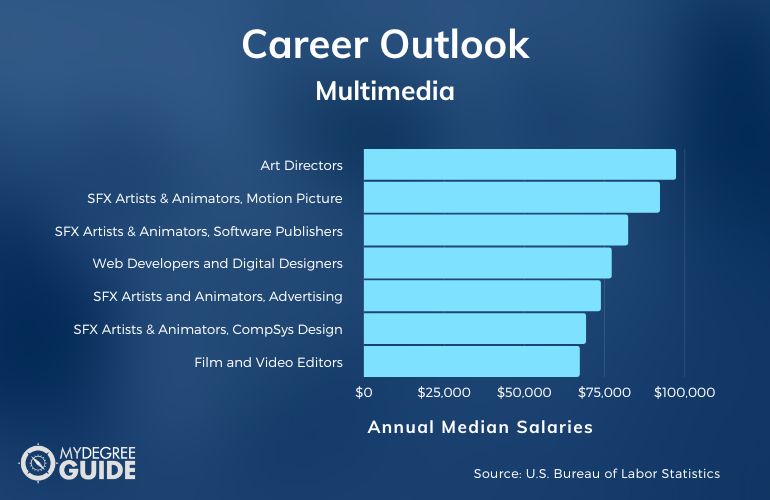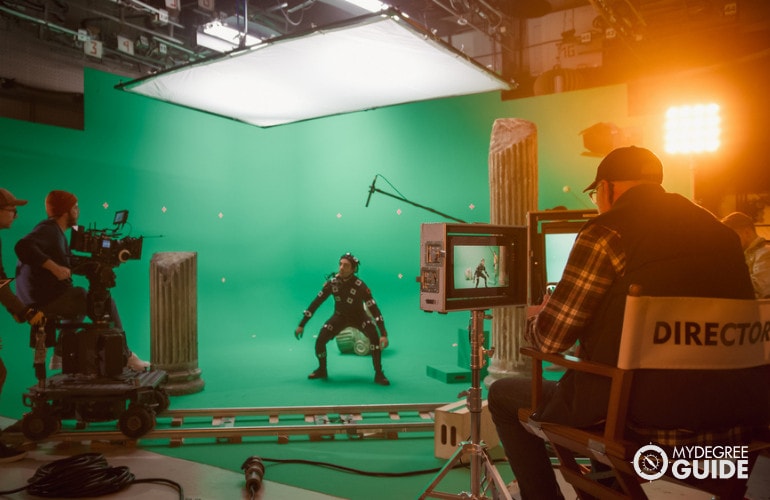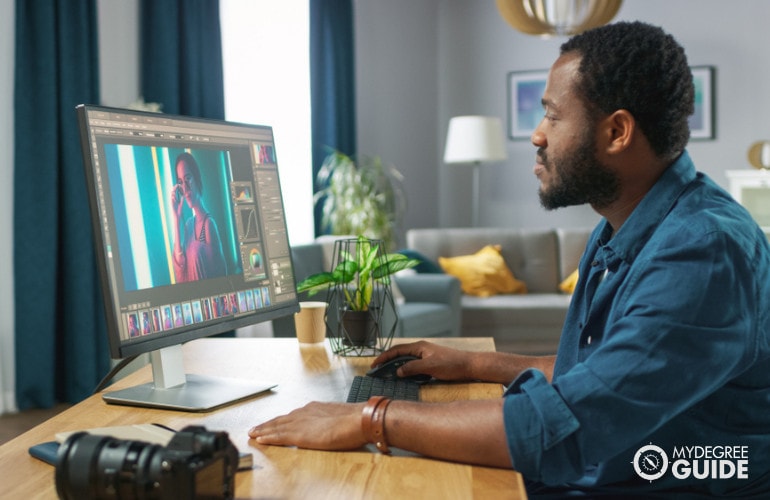Multimedia degree online programs offer many specialized pathways tailored to specific career goals.

Degree programs related to multimedia art and design can offer training for video production, web development, digital design, or graphic design work.
Editorial Listing ShortCode:
Digital communications have opened doors to intriguing new industries that could drive demand for creative professionals. If you have a flair for art and design, you may consider which multimedia degree best suits your goals.
Universities Offering Online Bachelors in Multimedia Design Degree Programs
Methodology: The following school list is in alphabetical order. To be included, a college or university must be regionally accredited and offer degree programs online or in a hybrid format.
California Baptist University
California Baptist University offers an online bachelor degree in graphic design and digital media. Students must complete 48 credit units related to their degree. The program can typically be completed in 16 months. Applicants must have a GPA of 2.0 or higher to be eligible for the program.
California Baptist University is accredited by the Western Association of Schools and Colleges Senior College and University Commission.
DeVry University
Devry University offers an online Bachelor’s in Multimedia Design and Development. Students may choose to add a specialization in either Graphic and Multimedia Design or Web Design and Development. Applicants must complete an interview with an admissions advisor before applying and be 17 years or older to be eligible for the program.
DeVry University is accredited by The Higher Learning Commission.
Franklin University
Franklin University offers a Bachelor of Science in Interactive Media and Design. To graduate, students must obtain 120 credit hours, with 24 credits open for electives. Students must maintain a GPA of 2.0 throughout the program. Applicants must submit proof of a high school diploma or an equivalent to be eligible for the program.
Franklin University is accredited by the Higher Learning Commission.
Granite State College
Granite State College offers a Bachelor of Science in Digital Media. Students must acquire 120 credits with a GPA of 2.0 or higher to graduate. Applicants are accepted on a rolling basis. To be eligible for the program, applicants must have a high school diploma or equivalent.
Granite State College is accredited by the New England Commission of Higher Education.
Johnson and Wales University
Johnson and Wales University offers a Bachelor of Science in Digital Marketing and Social Media. The online classes last either 8 or 16 weeks, typically allowing the program to be completed in 4 years. Students need to acquire 120 credits to graduate. Applicants must have a high school diploma or equivalent and 2 years of work experience.
JWU is accredited by the New England Commission of Higher Education.
National University
National University offers an online Bachelor of Arts in Digital Media Design. Each class only lasts for 4 weeks to help students obtain the 180 necessary credits faster.
Applicants must have a high school diploma or the equivalent with a GPA of 2.0 or higher. If the applicant does not meet the GPA requirements, they may write a petition letter to have their application reviewed.
National University is accredited by the WASC Senior College and University Commission.
Pennsylvania State University
Pennsylvania State University offers a Bachelor of Design in Digital Multimedia Design. Students must complete a minimum of 120 credits with a grade of C or higher to graduate. To be eligible for the program, applicants must have a high school diploma or an equivalent.
The Pennsylvania State University is accredited by the Middle States Commission on Higher Education.
Texas Tech University
Texas Tech University offers a Bachelor of Arts in Digital Media and Professional Communication. A minimum of 120 credits are needed to graduate, and the program usually takes 4 years to complete.
Applicants must submit high school transcripts and either their ACT or SAT scores. Those with test scores in the top 10% are usually admitted without issue.
Texas Tech University is accredited with the Southern Association of Colleges and Schools Commission on Colleges.
University of Florida
The University of Florida offers an online Bachelor of Arts in Digital Arts and Science. To graduate, students must complete 120 credit hours with a GPA of 2.5 or higher in critical tracking courses. Applicants must have a high school diploma or equivalent and need to submit SAT or ACT test scores to be eligible for the program.
The University of Florida is accredited by the Southern Association of Colleges and Schools Commission on Colleges.
University of Maryland Global Campus
The University of Maryland Global Campus offers an online Bachelor’s in Digital Media and Web Technology. To graduate, students must complete 120 credits, with 49 credits dedicated to electives. To be eligible for admission, applicants must have a high school diploma or an equivalent.
The University of Maryland Global Campus is accredited by the Middle States Commission on Higher Education.
Multimedia Degrees Online
In multimedia industries, development work includes inception and conception stages that may demand a high level of imaginative creativity. Design-related production work follows this creative stage and can include digital design, coding, and engineering roles.
As you consider a multimedia major, it may help to think about where you see yourself in these collaborative efforts. You can then match your career goals and interests with the right online multimedia degree options.
Select the program that most interests you to jump to that section of the guide:
Regardless of the specialty you select, you will still receive a strong foundation in multimedia design and related courses.
Multimedia Design

As a multimedia design major, you’ll likely get training in creative and practical artistic design skills and methods. Courses typically cover a range of digital media production skills, such as video and film production, television production, and web and video game development.
Editorial Listing ShortCode:
More traditional media, such as magazines and books, also require contributions from skilled media design specialists. Also, marketing collateral is often made now for social media and the internet, requiring marketing directors and creative agencies to seek out skilled multimedia designers.
Graphic Design & Media Arts

Media arts professionals with a graphic design specialization often help create art and graphics for any number of commercial applications. These can include designing business cards, logos, sales brochures, and other branding collateral. They can also integrate esthetic elements across any number of branding and marketing assets.
Editorial Listing ShortCode:
Programs typically include training in traditional art and design principles. They also cover methods for practical and commercial applications, including the skilled use of typography, color, and illustration. Skilled graphic design professionals may work as freelancers or as in-house art contributors or directors.
Computer Animation

As a computer animation major, you’ll learn about the computer animation development process. You can also learn practical skills used across an animation development pipeline, such as storyboarding, character design, background design, and modeling.
Computer animation is a good major for many students, as this field is becoming highly automated and software driven. So most computer animation degree programs will give you training in the most relevant industry software tools.
Editorial Listing ShortCode:
Do you want to manage production teams one day? If so, you might want to look for programs that also offer training for artistic directors and project managers. It may also be beneficial to earn an animation masters degree at an accredited university.
Larger media projects—including video games and full-length film productions—require extended production times and the coordination of collaborative teams.
Multimedia Careers & Salaries

Some graduates want to work as solo freelancers and assist smaller businesses. If this is you, you could develop generalized skills in a range of design and media arts applications for business development, web design, video production, and creative marketing work.
Many multimedia artists develop more specialized skills and work with numerous collaborators on larger media initiatives. According to the Bureau of Labor Statistics, with the right training and professional experience, these various areas of specialization could open doors to any number of media-related careers.
| Careers | Annual Median Salaries |
| Art Directors | $97,270 |
| Special Effects Artists and Animators, Motion Picture and Video Industries | $92,250 |
| Special Effects Artists and Animators, Software Publishers | $82,330 |
| Web Developers and Digital Designers | $77,200 |
| Special Effects Artists and Animators, Advertising, Public Relations, and Related Services | $73,820 |
| Special Effects Artists and Animators, Computer Systems Design and Related Services | $69,200 |
| Film and Video Editors | $67,250 |
| Sound Engineering Technicians | $53,520 |
| Graphic Designers | $53,380 |
| Desktop Publishers | $47,560 |
Getting specialized training in the use of software tools related to photo editing, video editing, web design, or animation and special effects can lead to rewarding opportunities. Those with multimedia savvy may also find intriguing jobs in project management or as artistic directors.
Careers in the multimedia sector can take quite different paths, depending on the technical and creative skills you choose to focus on.
How to Choose an Online Multimedia Degree

There are many types of multimedia degrees, such as an animation degree, digital design degree, and graphic design degree.
Taking stock of your own aptitudes and professional goals and interests can help you choose your preferred major or specialization among the many online multimedia degree programs. The following factors can also help you narrow down your options:
- Specializations. Not all programs offer the same major or concentration options.
- Format. Some online digital media degree programs allow you to enroll part-time while others offer an accelerated path toward graduation.
- Cost. The cost of tuition and additional fees vary between schools and programs. It can help to compare prices of your top schools.
- Length. Some programs require more credit hours than others. A longer program may allow you to receive more in-depth training while a shorter program may allow you to finish sooner.
Comparing different multimedia degree programs and offerings can make it easier to decide which skills, specializations, and courses are most important for your professional goals.
Bachelor’s in Multimedia Curriculum

Courses and areas of concentration can vary by school and program, but here’s a sampling of the training you may find in digital multimedia programs online:
- Web Technology: You’ll learn about fundamental web technologies and web development practices.
- Introduction to Graphic Design and Typography: This course covers fundamental non-digital graphic design and typography concepts and methods.
- Visual Communication: You’ll explore design concepts and digital tools that aid in creative and effective visual communication design work.
- Multimedia Integration: You’ll learn about multimedia authoring tools and techniques and create interactive websites and web-based applications that integrate images, text, video, sound, and animation.
- Website Architecture: You’ll learn principles of website design, navigation, architecture, and database integration.
- Multimedia Management: You’ll learn about issues critical to multimedia project management, to coordinating artistic teams, and to effectively managing a small multimedia business.
- Multimedia Tools Survey: You’ll explore and get acquainted with important industry-standard media designing tools.
- Publication Design: This course teaches a range of principles and methods that can help you design print publication concepts.
- Digital Animation: You’ll learn fundamental concepts and methods related to designing and coding digital animation effects.
- Introduction to Mobile Game Design: You’ll get introduced to industry practices and methods for mobile game design, from the conception stage through digital production, engineering, and testing.
Most programs offer you course concentrations based on specialized career paths, and some schools may offer more than one online multimedia pathway.
Admissions Requirements

Admissions requirements can vary by school and program, so it’s beneficial to check school websites and with your prospective school’s admissions office, as needed.
Admissions requirements for a bachelors in multimedia design might include:
- High school diploma or equivalent
- Satisfactory GPA
- SAT or ACT scores (if required)
- Letters of recommendation
Some relevant coursework, relevant software or coding knowledge, or a design portfolio may also be requested for admission to some programs.
Accreditation

Schools can earn an accreditation status by passing a review process carried out by an independent, third-party accrediting institution.
This process helps provide independent review and monitoring of a school’s academic programs, its general academic standards, and the quality of its student services. Sticking with regionally accredited schools can help ensure you’re receiving a verified academic education from a qualified faculty.
Accreditation can also be a precondition for some kinds of financial aid. In addition, other schools and prospective employers honor accredited academic accomplishments. The Council for Higher Education Accreditation (CHEA) has resources for finding accredited schools.
Financial Aid and Scholarships

Not all students can afford the upfront costs associated with tuition and other college expenses. If you qualify for financial aid, your options may include state and federal education grants, work study programs, need-based and merit-based scholarships, and student loans.
The terms of aid offerings can vary, so it’s helpful to look over any financial aid packages you receive. If you already work in the multimedia field, you might want to look into employer-based tuition assistance. When applying for aid, you can start by filling out the Free Application for Federal Student Aid (FAFSA).
Multimedia Arts Professional Organizations
Some students find it useful and educational to connect early on with a professional organization in the multimedia field.
Joining one of the organizations listed above could help you learn more about careers, find additional professional development opportunities, and start building a professional network.
What Is Multimedia Design?

Multimedia design is the study of practical design methods and practices that can be used in a number of industries and professions. Coursework typically blends learning about traditional graphic design practices with courses covering digital tools and methods.
Courses may cover interactive web designs, digital and film animation, video production and video editing, publishing design, commercial graphic design, digital photo editing, and video game design.
Programs in multimedia art and design often teach concepts related to traditional graphic design practices as well as digital and web-related design principles and methods. Many online multimedia degree programs also introduce students to relevant programming languages and software applications.
Is Multimedia Design a Good Career?

Yes, multimedia design is a good career for many professionals. Some positions in this field—such as film and video editor, web developer, and digital designer—are slated for above-average job growth over the next ten years (Bureau of Labor Statistics).
The median salary for arts and design occupations is $49,600, according to the Bureau of Labor Statistics. Multimedia positions, though, tend to have higher than average salaries. For instance, special effects artists and animators make a median annual salary of $77,700 while art directors earn a median wage of $97,270.
If you have creative and artistic interests and aptitudes, you may enjoy exploring the various multimedia specializations and career paths available.
What Can You Do with a Multimedia Degree?

Today there are a number of new digital and marketing assets, including websites, video messaging strategies, and digital special effects and video games.
These types of progressive technologies can drive demand for creative professionals with a range of specialized multimedia skills, both artistic and technical. A number of graduates pursue work in video or film production. They may do creative work, direct collaborative teams, or do technical production work.
Other jobs in this broad field include animator, special effects artist, sound engineering technician, art director, digital designer, and graphic artist.
After earning an undergraduate degree, a number of professionals in the field opt to continue their educations in an on campus or online masters in media studies program. Some universities even offer both traditional or online PhD in Media Studies degrees.
What Do Multimedia Artists and Animators Do?

Multimedia artists, designers, and animators combine art and graphic design skills with computer images and software to create illustrations, design motifs, and animated or fixed graphics.
Some multimedia designers and artists work collaboratively with creative teams to create films or video games. Alternatively, they may do specific tasks related to editing or special effects. Working in-house or as a freelancer, a multimedia artist might work in the entertainment, film, or video game industry.
They may also work in commercial website design or mobile app design. Some professionals in the field support publishing projects or lend their design expertise to creative digital and social media marketing efforts.
How Long Does It Take to Get a Multimedia Degree Online?

Getting an online multimedia bachelors degree generally takes 4 years if you attend full-time on a traditional 16 week semester system.
How long it takes, though, can depend on the program as well as your own schedule. Some online programs offer shorter course terms. If you follow an 8 week semester and stay continuously enrolled year-round, you might finish in less time.
Whether you’re interested in part-time, full-time, or accelerated study schedules, there are likely online multimedia degree programs that can meet your needs and interests.
What’s the Difference Between Graphic Design vs. Web Design?

Graphic design work focuses on the selection and skillful integration of multiple design elements, such as illustrations, photos, logos, design motifs, typography, and color.
Web design work may include graphic design skills, but it focuses on helping to engineer the proper display of design and text elements on web pages. A web designer may also develop the architecture and navigation features of multi-page websites.
| Graphic Designers | Web Designers |
|
|
Graphic designers and web designers have complementary skills. Some professionals will acquire skills in both areas, but many will collaborate with other specialists for the best results.
What’s the Difference Between Graphic Design vs. Animation?

Graphic design artists can use their skills to help create and design backgrounds, settings, objects, or characters used for animation. They may also use their skills for any number of artistic roles, such as designing publications, creating marketing assets, or designing websites.
An animation artist and special effects artist may use traditional design tools and paper for creating initial animation concepts. Most animation work will be done using specialized software programs and applications.
| Graphic Designers | Animators |
|
|
A multimedia designer may have skills in both graphic design and animation. In many work settings, though, the production of multimedia assets involves a team of multimedia designers and animators working collaboratively.
Is a Multimedia Degree Worth It?

Yes, a multimedia degree is worth it for many students. Skilled media artists might find rich veins of work in video production as well as website design for businesses and organizations across all sectors.
As interest in video gaming and mobile gaming apps continues to grow, this could be another rewarding career opportunity for graduates with the right multimedia training and skills.
Marketing is another field where you might find faster-paced, creative multimedia and design roles. Social media marketing, video messaging, and interactive website designs complement traditional forms of marketing and branding work.
Getting Your Multimedia Degree Online

If you enjoy creative design work, then you may be interested in earning a multimedia degree.
Many universities offer online programs for multimedia majors, so you’ll likely have a variety of study options and course specializations to choose from. The sooner you start exploring accredited online multimedia programs, the sooner you may find the artistic career path that’s right for you!
